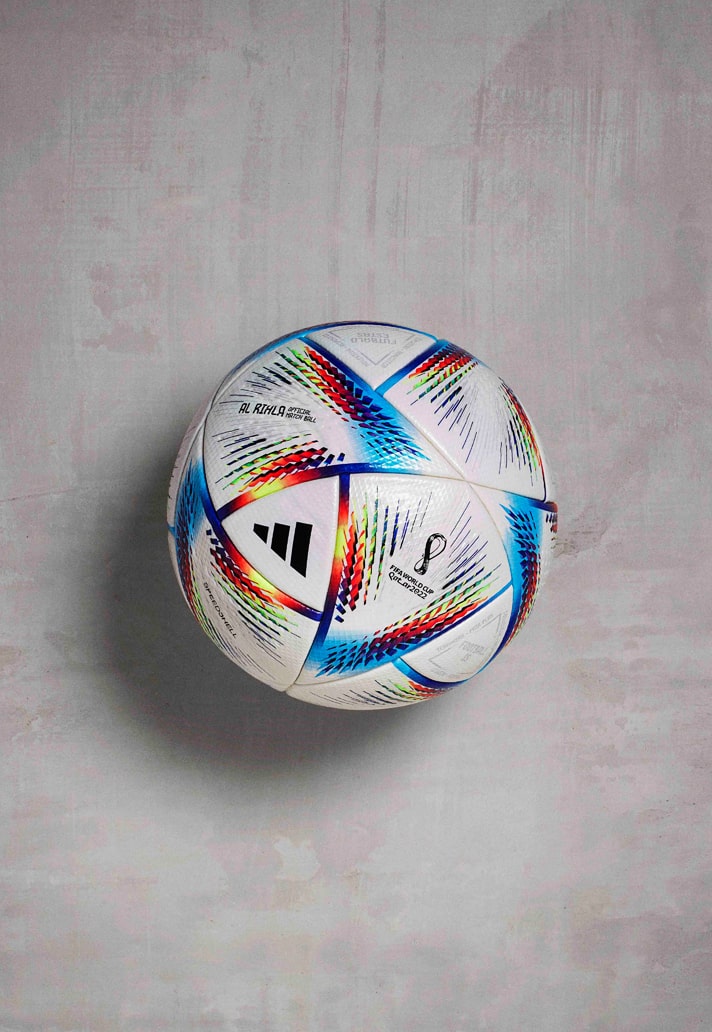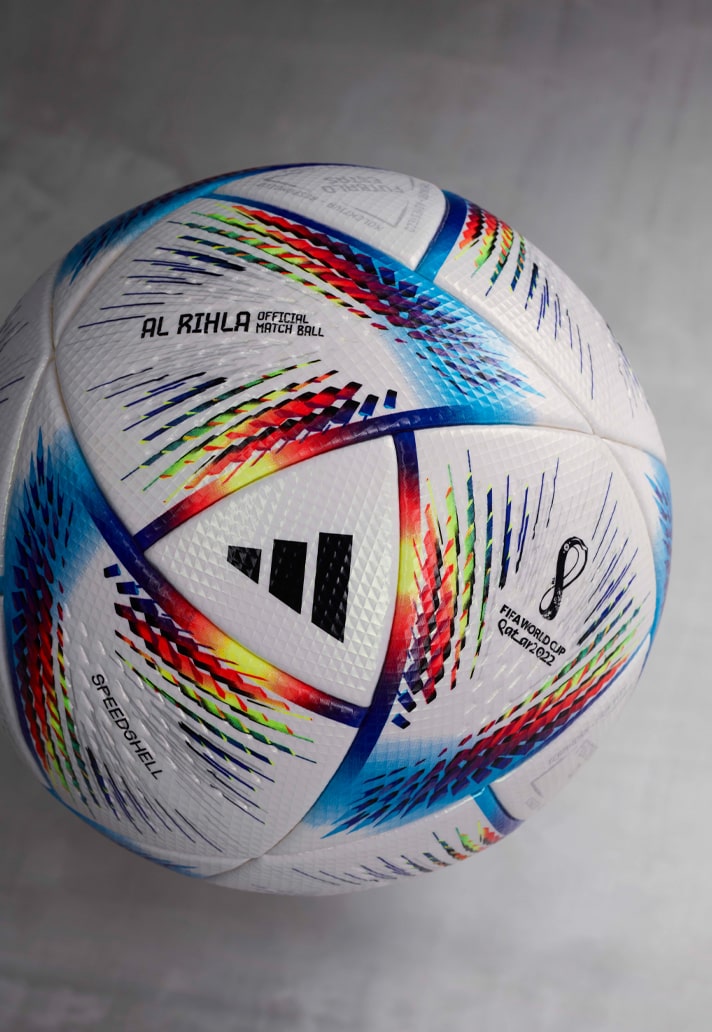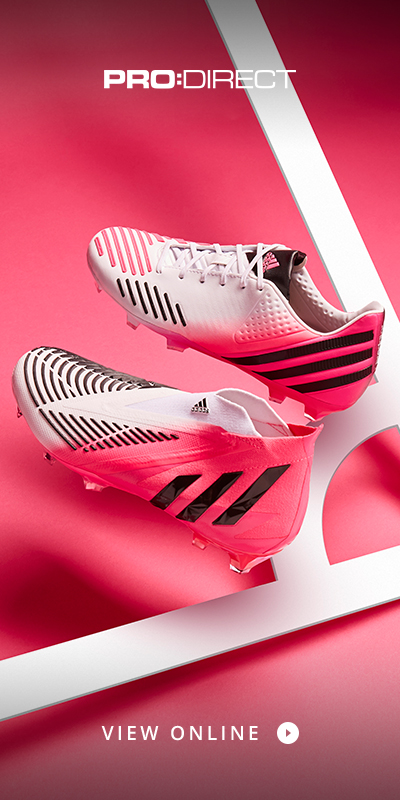Nothing quite encapsulates the feeling surrounding a World Cup like the official match ball. It is the focal point of the tournament before, during and after the action on the pitch, and memories are always intrinsically linked to it. No pressure when designing one then…
This week adidas unveiled ‘Al Rihla’, the official match ball of the 2022 FIFA World Cup in Qatar. It’s the latest in a long line of iconic designs from adidas – the 14th to be precise – and it arrives with a vibrant design that not only represents the tournament as a whole and the host nation, but also the ever-increasing speed of the game and the fact that it can travel faster in flight than any other World Cup ball to date. Add to all of that the fact that it's one of the first products to carry the new adidas Performance logo, and the pressure to get it right was really on.


The design process on a project like this is a monumental team effort, from start to finish, and one that began literally moments after France lifted the Jules Rimet Trophy four years ago. To get the inside scoop on the story behind Al Rihla and its development, we spoke with Oliver Hundacker, Senior Director, Football Product Development and Franziska Loeffelmann, Design Director, Football Graphics.
The World Cup ball is such a prestigious thing to be involved with. What was it like on a personal level first and foremost?
Franziska Loeffelmann: Special, always special. I started working for adidas 10 years ago and had a part to play in the Brazuca then the Telstar 18, and now obviously Al Rihla. It’s amazing. For me personally there couldn’t be a better thing to do day to day. We work with such a broad team from all over the globe and everybody brings the same passion. It’s loud, it’s very good conversations, thoughtful, creative, lots of music… the atmosphere within the team is really special and I’m so happy that we’re part of that.
The match ball is obviously something special that people remember from each tournament. Did that thinking about the past form a lot of the ideas when initially sketching out the project?
Oliver Hundacker: Of course, I can totally relate to what you’re saying. I can still remember the days when I was a small boy and it was the World Cup in Argentina in 1978 and there was this one guy who showed up with the new Tango ball and everyone wanted to have a kick with that ball, everyone wanted to play with it, and I think at that moment I really realised the power and the importance of the ball.
Throughout my career I’ve had the opportunity to work on a couple of these balls and I always felt so excited because I knew the beginning… You start with an idea and at the end you end up with a ball that the entire world is watching. It’s almost the face of the tournament.
You start with an idea and at the end you end up with a ball that the entire world is watching. It’s almost the face of the tournament."
It will catch the eye when I’m motion, can you tell us about the inspiration – where do you start with something like this?
FL: The starting point for us as a group is the most exciting ‘Dream Phase’, as we call it. It’s where we really lock ourselves in, get our headspace around the project. I mean, it’s the first World Cup in Qatar, the first World Cup in winter, but also it’s the first World Cup where we want to give the players a faster ball. The ambition was high and the start of this journey was already mega-exciting.
We started right when France lifted the trophy in 2018, and it’s obviously been a long journey; a journey with highs and lows, but we really really liked it. Qatar played a really big part in terms of influence in the design. You can see from the design how the national flag influences it. In the speed graphic itself you can see the modern architecture. But also the iconic patterns have been an influence on the whole ball, but we really brought it to life, brought the energy, through the colours.
I think the whole way, from starting with the bladder to what we have now is just an amazing journey, and it really looks like that too.
This World Cup is so different for a number of societal reasons. How do you block out the noise and keep a feeling of good energy in a design given the circumstances?
OH: I think that pretty much depends on the briefing. It was clear that we wanted to come up with a more accurate and faster ball. We also wanted to keep the environment in mind when creating the new ball. So we had three different factors that we had to explore. On the other side we had a really strong benchmark with the Telstar 18, so to make that even better you have to be really careful that you’re not over doing it. So to find the right ingredients, to use the right recipe to come up with an even better ball I think requires a lot of thought.
The dedication and the passion from the team was really visible, and you could feel it. People live for football on our team.


Let’s get into the design on a surface level first. The aesthetic – can you tell us about the use of colour?
FL: The pattern is really inspired by the architecture in Qatar. You see these amazing buildings – they are very forward thinking in their designs there. And also speed obviously; you have a fast ball but you also want to translate it visually. So I think the colour approach is really coming from the nature that surrounds Qatar: the sunset in a desert, the red and yellow tones that blind you mind, also the blue tones of the ocean that we also really want to protect. And with the speed aspect in mind it’s that mix, that explosion of emotions, and I think that’s captured quite nicely.
With the visuals, how does that fit into the design process?
FL: Sadly, to be quite honest, this time we were not personally travelling, living instead in a world of Teams and being connected virtually. We had our expert teams and we sent them out with a lot of questions. With a fluent conversation in Qatar they came back with many pictures that inspired us, brought us the answers we were asking for. So it was not a personal journey, but we adapted to get to where we wanted to be.
Under the hood, the construction – the panels are distinctive. Can you tell us about the engineering there?
OH: When it comes to the panel shape configuration it’s really the most prominent feature of the ball. And as you can see when looking at the ball there’s something that we haven’t talked about yet and it’s that pearlised coating on it, so when you just look at the white ball, it’s already a beauty in my eyes.
But it was really informed by data and the simulations that we were driving through wind tunnel tests and our robotic kicking devices, where we can clearly figure out what is needed to improve the aerodynamics of the ball, to decrease the air resistance, and also to make the flight path more predictable and concise.
It’s a mixture, a sweet spot that we were able to define it. Because we also wanted to reduce waste, so the yield of the new panels is also significantly lower compared to Telstar, which is good for our sustainability efforts. But then you also have to have the manufacturing part in mind. It needs to have an efficient and effective manufacturing process.
So ultimately, with all these given ingredients, I think we’ve ended up in a very nice place.


I think the best feedback that you can get is when the players don’t want to give the ball back because they like it and feel at ease with it. The ball does what the player wants it to do."
Things like the Jabulani and the Brazuca, so much was made about the way those balls moved. What’s the objective when looking at new constructions of footballs like this?
FL: The focus is that we really want to equip the players with the best gear. The game is getting so much faster, so we want to equip them with the best ball; one that has a really good flight and reliability. I think it is radically different, yes, but for good reason, that being that we really want it to be a part of the fast-paced action.
What’s the response been like from the players so far?
OH: As I said, we tested the ball quite rigorously around the world, and I think the best feedback that you can get is when the players don’t want to give the ball back because they like it and feel at ease with it. The ball does what the player wants it to do. That’s the position and consistency aspect that we really had in mind. I think some of the elements were greatly improved from the Telstar 18, yet it was not such a radical step for them to get acquainted with the new ball. That is probably the one bit of feedback that I’d like to share: players really wanted to keep playing with them. They said “why are you holding this back and only introducing it for the World Cup?!”
With the new Three Stripe branding and the ball being the face of the World Cup, as you’ve mentioned, do you feel like this is quite symbolic of a new phase that adidas is entering into in general?
OH: Yeah, that’s correct. It’s actually the first product that we’re introducing with the new logo, which will be the official logo for the adidas performance side. It’s the first time that we’re introducing this new logo and you will see it a lot more going forward.

Pick up the adidas Al Rihla official World Cup 2022 match at prodirectsoccer.com






















